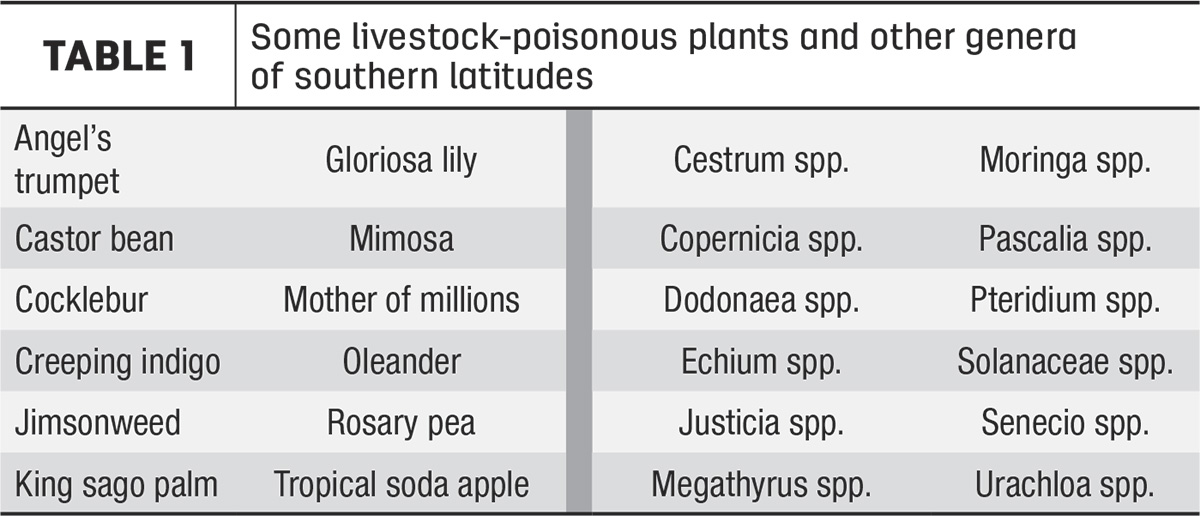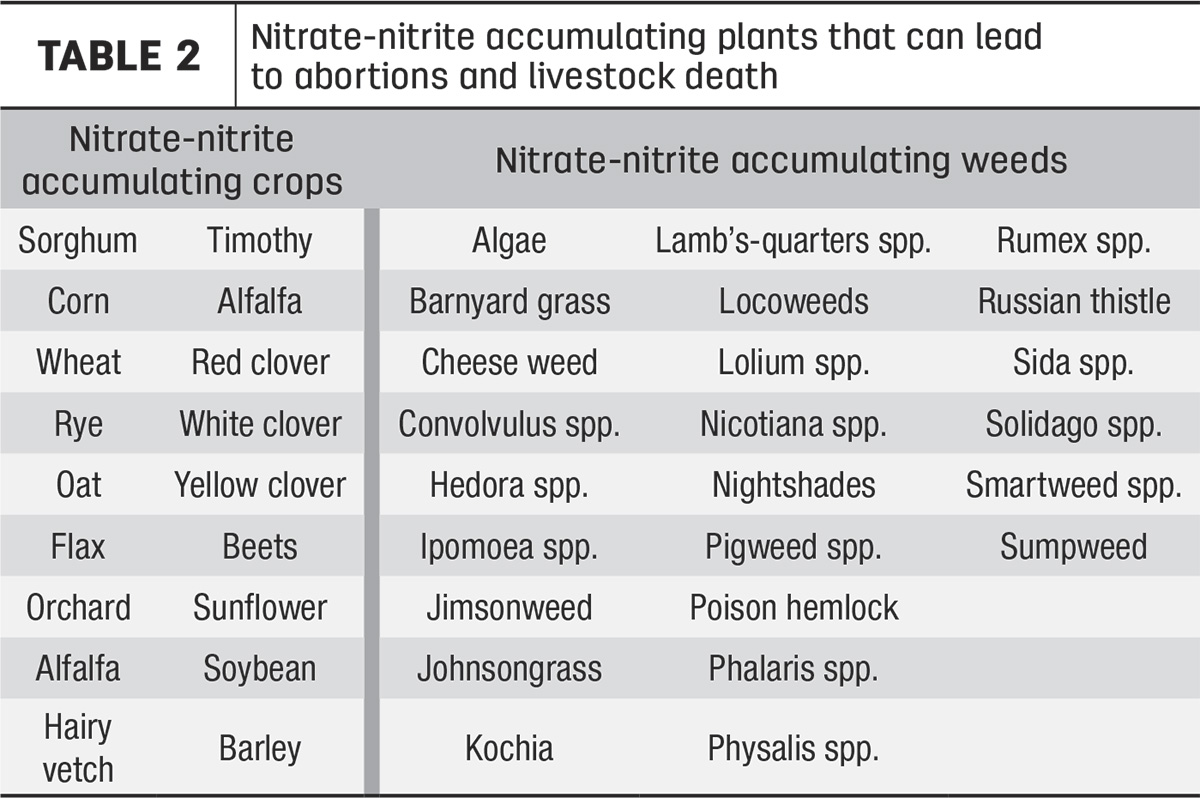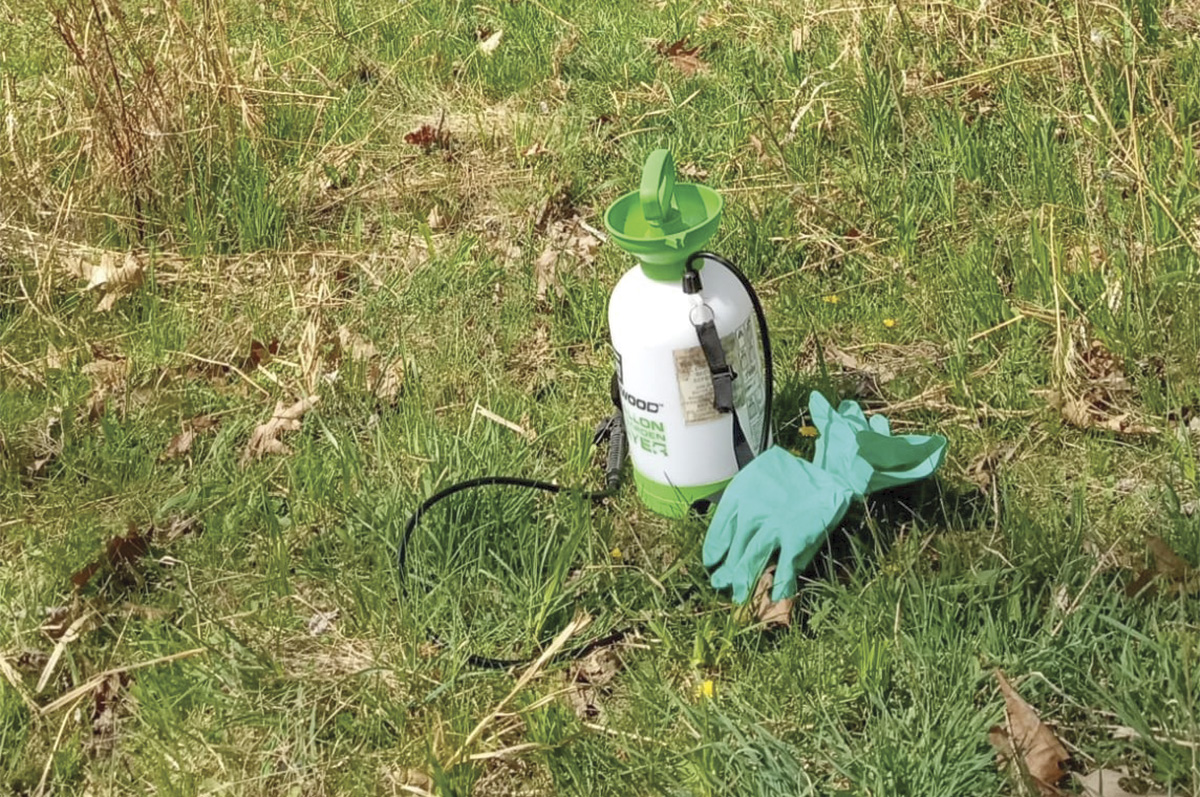Today, we know that many, if not most, herdwide abortions are viral or bacterial in origin. Immigrant farmers who came to North America from Europe and Central America prior to the late 1800s did not know about bacterial leptospirosis (1888), viral brucellosis (1897) or viral bovine diarrhea (2000) as causative agents. Introduced toxic plants like poison hemlock and the locoweeds of Mediterranean origin were generally considered the cause. That or inbreeding. Inbreeding to select desired traits liked pollness dates back to 6,000 B.C., if not earlier. Undesirable genetic traits causing fetal abnormalities have occurred throughout the evolution of livestock selection. There are more than 20 genetic traits cattle breeders monitor in the A.I. industry.
Non-native toxic weeds first arrived in North America in manure, boat ballast, fleece and feed. Other toxic-to-livestock forbs were purposefully sown as medicinal household herbals or introduced as ornamentals for the cultural landscape. In the 1870s, the use of synthetically derived nitrogen led to the first (1895) reported cases of cornstalk poisonings from nitrates. Botanical societies and the U.S. government actively searched for and imported non-native plants from the late 1700s on up through the 1950s. The toxicity of the imported Japanese flowering cherry trees in 1910 was not the primary reason the scale-infested shipment of 2,000 trees was destroyed. It would take until the Plant Pest and Quarantine Division of the USDA formed in 1972 to get serious about importing and cultivating toxic plants. There are now 114 regulated weeds and plant parts on the Federal Noxious Weed Act of 1974 list. The vast majority of regulated federal weeds are not poisonous plants but are otherwise deleterious to agriculture production practices. State noxious weeds, especially those in the major livestock regions of North America, go much further to regulate livestock-toxic plants.
Let’s take a look at some examples of non-native and native toxic-to-livestock plants that can harm the developing fetus or outright kill the dam. Some are commonly found in the U.S. Some are limited to a geographical region; others have not yet made their way to North America.
Subtropical toxic indigo species
Some readers might recall equine deaths in Florida in the 1970s related to a subtropical landscape plant native to the region of Guatemala. The losses were referred to as "grove poisoning." The culprit, a low-growing annual called Indigofera spicata, creeping indigo. In 2021, pet food-related dog deaths in Australia occurred from indospicine residue derived from the meat of livestock that had grazed either the native Indigofera linnaei (nine-leaved indigo) or the introduced I. spicata. Many other species of indigo are not toxic. Indigofera tinctoria, or true indigo, is a perennial shrub used for dye-making all over the world and is not toxic. For more information about the poisoning risks of creeping indigo in the U.S., see the fact sheet developed by the University of Florida Large Animal Veterinary Hospital.
North America reproductive harmful plants
In addition to native locoweeds, we know of 30 species in the highly toxic broom snakeweed (Gutierrezia spp.) genus native to the western rangelands of North America and onward into South America that induce abortions in livestock.
False hellebore, Veratrum californicum, is not an abortifacient but it does cause fetal deformities and is especially toxic to sheep. In the lily family, these perennial plants with exceptionally toxic roots have teratogenic toxins. Due to the similarity of the name, producers should learn to distinguish veratrum species from the hellebore genus, a group of plants in the ranunculus family (buttercups). Because hellebores are in the buttercup family, they are presumed to have similar toxicities. For example, published Natural Product Research Journal studies have identified cytotoxic and genotoxic cell death toxins in hellebore spp.
South America and southern latitude toxic plants
Desert-type poisonous plants commonly found in the cattle-rich cultures of the continents of South America, Asia, Africa and Australia have largely stayed put due to climate boundaries. However, recent desertification of parts of western and southwestern North America makes successful establishment more probable in the near future. I’ve listed a few southern latitude livestock poisonous plants readers might be interested in learning more about in Table 1. Some you will recognize as already being established in North America. The others are genera known from South America that are quite toxic to livestock.

The continent of South America, home to some 70 million head of cattle, has a slew of poisonous livestock plants we’re not that familiar with farther north. The same goes for Australia. With more than 300 U.S. cities across the country reporting record-breaking temperatures or precipitation shifts every year, it is foreseeable a shift in range of southern latitude toxic-to-livestock plants will occur as birds, wildlife and humans continue to migrate.
Characterizing likelihood of pregnant cow exposure
As mentioned in a previous article, the big worries in North America for grazed abortifacient plants are: little buttercup, Ponderosa pine, lupines, poison hemlock, broom snakeweeds and locoweeds. Fires, droughts and flooding, coupled with high winds and the movement of plants and plant parts (by hoof and by trailer, by man or by beast) can disperse weed seeds long distances. Flooding in particular can deposit weed seeds over a large area of agriculture ground. Once these poisonous plants become established in a specific biome, it may or may not be practical or advisable to get rid of the plants due to risk of controlling desired grazing species. Prevention, early detection and rapid response to prevent seed maturation are steps individual landowners can take to limit spread once this occurs.
Limiting stocking density strategy
It’s just not feasible to remove every single cherry, Ponderosa pine, Monterey cypress, lodgepole pine, juniper or mimosa in one calving season on large tracts of rangeland. We might try to limit overstocking, which forces grazing animals to consume more and more unpalatable vegetation to meet daily intake requirements. But in practice, this has rarely occurred in the past and won’t occur in the future unless producers are paid more for the value of producing weed-free commodities as an environmentally sustainable practice. A reward perhaps for having zero poisonous plants on the range? That would be a win-win future farm bill program.
If abortifacient plants are present, assigning stocking density thresholds (number of bredback cows or cow-calf pairs, per acre) in areas with known toxic plants might reduce the odds of consumption. Or at the very least, avoid infested areas during the last trimester. The more non-toxic palatable forage available, the less likely pregnant animals will consume something harmful. Restricting exposure to the least toxic period of plant development is another limit-use strategy.

Nitrate-nitrite accumulation threshold strategy
In Table 2 are 43 types of plants that are known nitrate accumulators, which can lead to abortions and livestock death. The veratrum species found in North America (false hellebores) are not in this table, but they do contain a toxin that causes malformation of the fetus. They cause severe poisoning in sheep and also affect cattle and goats. They could be luxury consumers of nitrogen and are outright lethal in their own right.
Some of these plants are legumes that also produce their own nitrogen-fixing bacteria. Death by nitrate toxicity occurs when intake of 2,000 parts per million (ppm) to 10,000 ppm of nitrate in leaves, stems or roots (bulbs) are ingested. (It’s a complex combination of species susceptibility, exposure and dose.) In general terms, the nitrite is absorbed into the bloodstream of the mom and her fetus. In the bloodstream, nitrite combines with hemoglobin into methemoglobin. Methemoglobin doesn’t bind to oxygen and suffocation ensues. Best advice: The more time grazing animals have to acclimate their tummy microbes from a forage with low levels to one with rising nitrate levels, the better the outcome.
In scenarios where high nitrates could become an issue due to weather conditions and crop growth stage, the best options are complete avoidance or supplementation with stock feeds before turning out. Depending on which specific toxic plant is present, grazing before nitrogen uptake peaks or grazing after nitrogen uptake drops often works out just fine. Producers can test forages and water for nitrate content. But do this before turning out. The effect on the cow is often instantaneous or has been reported to occur three to seven days after continuous exposure.

Early detection and rapid response can limit the spread of toxic-to-livestock weeds. Photo by Melissa Bravo.
Wetland plants
Another potential source of nitrate-nitrite abortifacient toxins are aquatic and semiaquatic plants, plant parts in irrigation ditches, grazed waterways and in standing ponds. Wetland plants are essentially nitrogen accumulators. Eukaryotic algae can absorb up to 60% of their dry matter weight as nitrogen. Think about that. If a thirsty cow sucks down 5 gallons of algae-laden water, she could be taking in a significant amount of nitrate. Pump it up with stormwater discharge after a nearby crop field just got side-dressed, and you might have an issue. Grassy and grazable wetland indicator plants like phalaris may naturally contain high levels of nitrate in their leaves as they senesce. Even without adding fertilizer runoff.
Nitrate-nitrite toxicity treatment
A slow drip of no more than 1% to 2% or less of methylene blue may reverse the effects of nitrate poisoning if animals can be kept calm. Having activated charcoal on hand and in enough quantity to be useful is a good idea for some ingested poisonings, but not all. There are no veterinarian-available diagnostic tests for poisonings from cyanotoxins. There are no known antidotes to cyanotoxins or specific treatments for illnesses caused by cyanobacteria and their toxins. Or for the highly toxic South Africa fireweed, Senecio madagascariensis. Fireweed is now found in Argentina, Brazil, Colombia, Hawaii, Kenya, Japan, Venezuela and Uruguay.
Field autopsy
Most toxins can be extracted from the liver to determine cause of death. Nitrate poisoning can be determined from ocular fluid. Veterinary diagnostic clinics that have access to the whole animal can sample the digestive tract, kidneys, cervical fluid, heart and blood, the skin and the reproductive tract.
Resources
Sites like Cornell’s Plants Poisonous to Livestock give us access to vast amounts of global encyclopedic knowledge. Books like Weeds of the Northeast and Weeds of the Midwestern United States and Central Canada make identification somewhat easier. Remember, causative death for regulatory indemnification or insurance verification may require definitive plant identification by a third party.
Melissa Bravo, Meadow Lake Farm, is the former poisonous plant and noxious weed program manager for the Pennsylvania Department of Agriculture.









